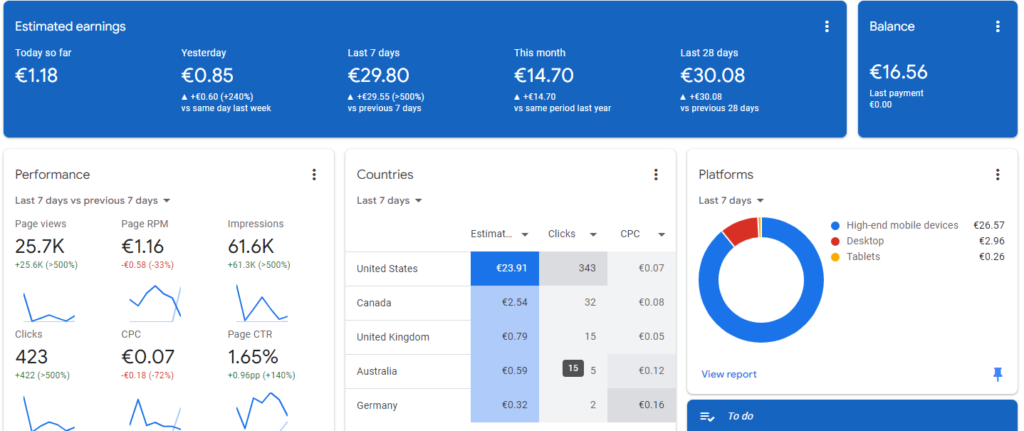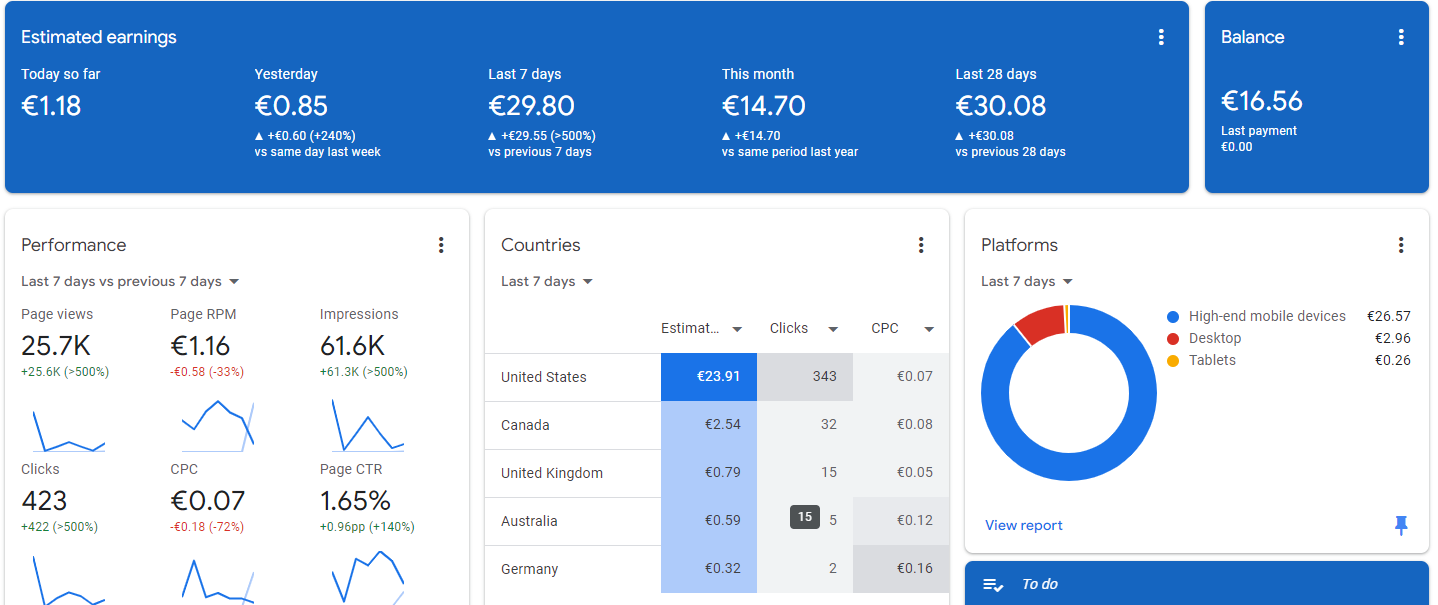It looks like you’re experiencing a low Cost Per Click (CPC) problem, despite having traffic from top-tier countries such as the United States, Australia, and Canada, according to your Google AdSense dashboard screenshot. Let’s dive into why this could be happening and how to potentially address it.

What is CPC and Why Does it Matter?
CPC stands for Cost Per Click, which is the amount you earn every time someone clicks on one of your ads. For publishers using AdSense, CPC rates are influenced by various factors like audience location, website content, advertiser competition, and even user behavior. Higher CPC rates generally mean more revenue for fewer clicks, which is why it’s a critical metric to watch closely.
From your screenshot, your CPC for the U.S. is €0.03, which is quite low, especially considering it’s a high-value region for advertisers. Typically, advertisers pay more for traffic from countries with higher purchasing power like the U.S., UK, Australia, and Canada. So, if you’re seeing low CPCs despite traffic from these regions, something’s definitely not adding up.
Reasons Behind Low CPC from Top-Tier Countries
- Niche/Content Relevance
- If your website content is not closely related to high-paying industries, like finance, law, insurance, or technology, advertisers might not be willing to pay much for ad clicks. Advertisers in niches like entertainment, blogging, or lifestyle generally pay less, resulting in a lower CPC.
- Ad Placement and User Interaction
- Poor ad placement can negatively affect your CPC. Ads that are placed in areas where users tend to ignore them (for example, in the footer or in-between long paragraphs) are less likely to get clicks. Low interaction can lead to less valuable ads being displayed, lowering your CPC.
- Ad Competition in Your Niche
- If there’s limited competition among advertisers for the keywords your content ranks for, AdSense will serve lower-paying ads. More competition leads to higher bids, which drives up CPC.
- Ad Blockers
- Ad-blocking software reduces the number of times your ads are seen, which impacts overall clicks and earnings. Visitors from countries like the U.S. and the UK are more likely to use ad blockers, further impacting your CPC.
- Ad Types and Formats
- Not all ad formats perform the same. For example, text ads generally have a lower CPC compared to image or rich media ads. If your site is mostly displaying text ads, that could be a reason why your CPC is on the low side.
- CTR (Click-Through Rate) and Bounce Rate
- Low engagement metrics, such as a low click-through rate (CTR) or high bounce rate, could signal to Google that users are not finding your content useful. This can lower your CPC because advertisers value engagement.
- Advertiser Budget Cycles
- Some industries experience seasonal dips in advertising budgets. For example, travel companies might spend less during off-peak seasons, reducing competition and lowering CPC.
- Geo-targeting and Device Types
- According to your screenshot, the majority of your ad revenue comes from high-end mobile devices (€1.07) compared to desktop (€0.10). Advertisers might be paying less for mobile clicks, even though mobile traffic can be quite high.
Action Plan to Boost CPC
Here are a few actionable steps to tackle the issue:
- Content and Keywords Optimization
- Start targeting high-paying keywords by creating content around topics that are more likely to attract advertisers willing to pay higher CPCs.
- Conduct a competitive analysis to understand which niches and topics are getting the highest CPC and align your content accordingly.
- Optimize Ad Placement and User Experience
- Implement Google’s Auto Ads for dynamic ad placements or manually experiment with prime ad spots, like in-content or above-the-fold positions.
- Focus on improving the overall user experience on your site, as better UX can lead to higher engagement and clicks, which can boost CPC over time.
- Diversify Ad Formats
- Explore native, in-feed, and responsive ad formats that may attract higher-paying clicks.
- Regularly check your AdSense reports to see which ad formats are performing best in terms of CPC and adjust accordingly.
- Seasonal Content Strategy
- Align your content creation with advertiser spending trends, especially around high-spending times like Black Friday, holiday seasons, and product launches.
- Consider targeting industries that are less susceptible to seasonal dips in CPC, such as finance, insurance, or real estate.
- Monitor and Experiment
- Regularly analyze your AdSense performance report. Look for patterns in traffic, regions, and devices to optimize accordingly.
- Try A/B testing different ad sizes, formats, and placements to find the optimal setup for boosting your CPC.
Conclusion
While it can be frustrating to see low CPC rates from top-tier countries like the U.S., there are many variables that impact it, from content relevance to ad placement and user engagement. By refining your content strategy, optimizing ad placement, and diversifying ad types, you should be able to boost your CPC over time.
Remember, increasing your CPC won’t happen overnight. It’s a continuous process of testing, optimizing, and understanding your audience better. With patience and some tweaks, you’ll likely see an improvement in your ad revenue.

